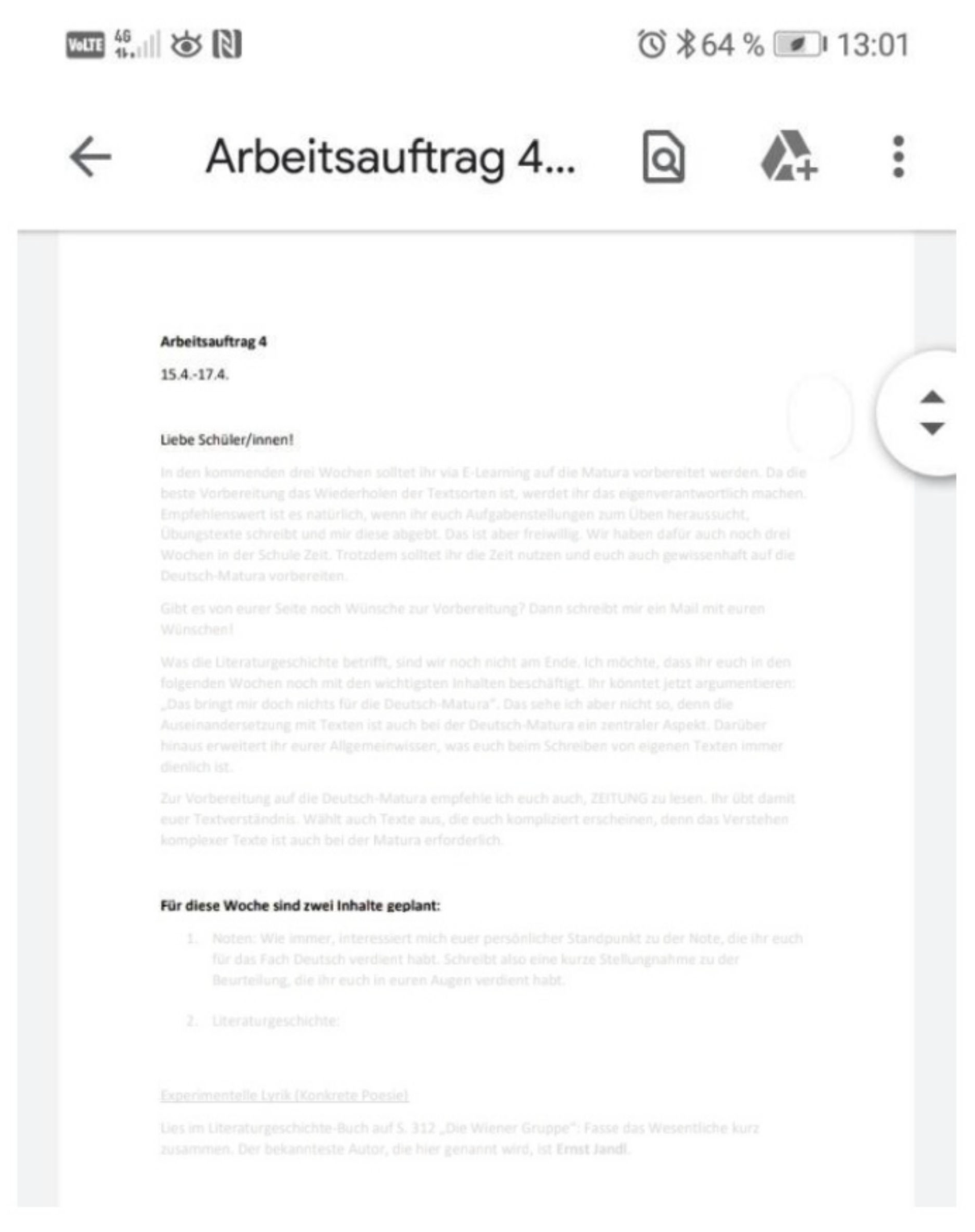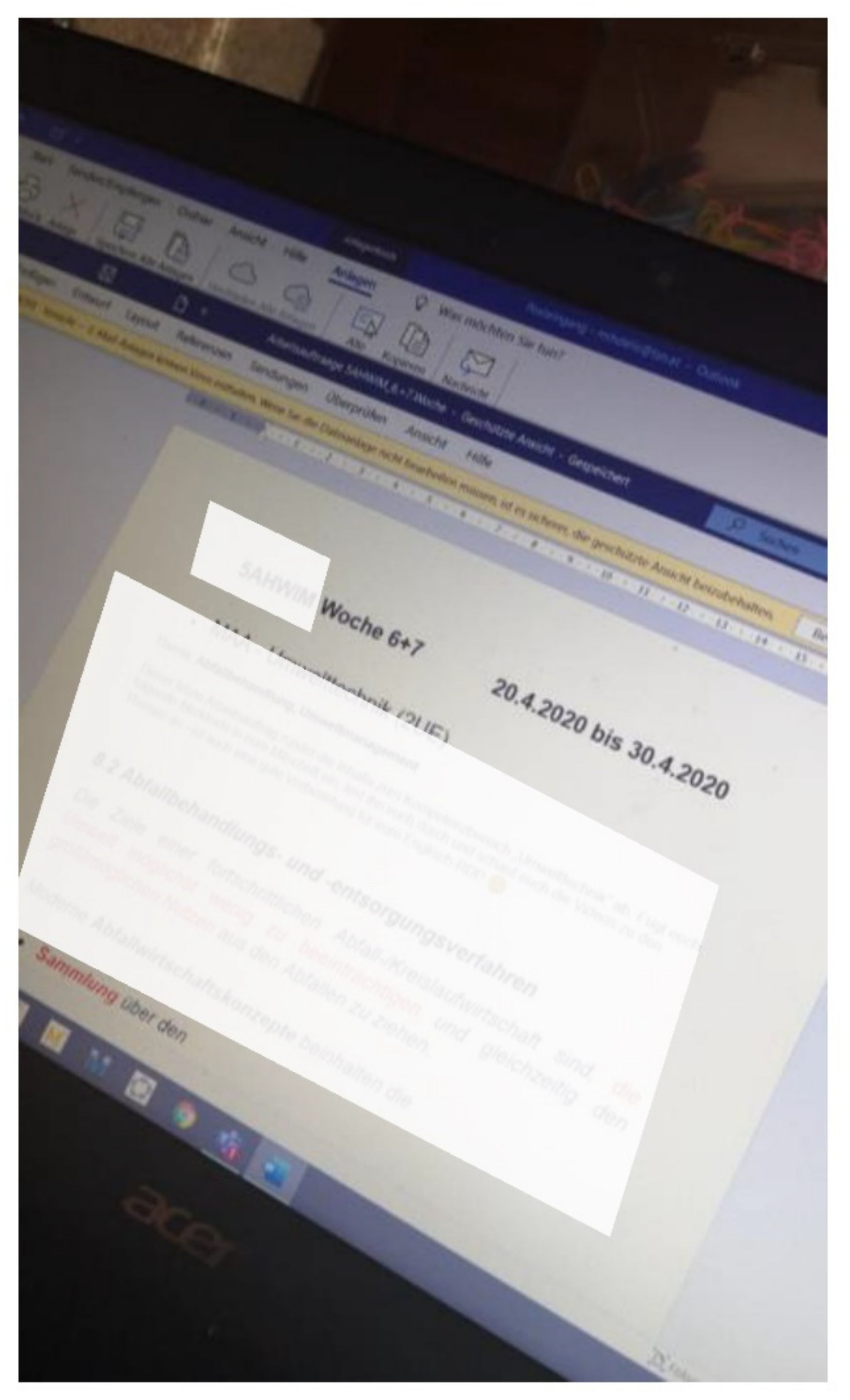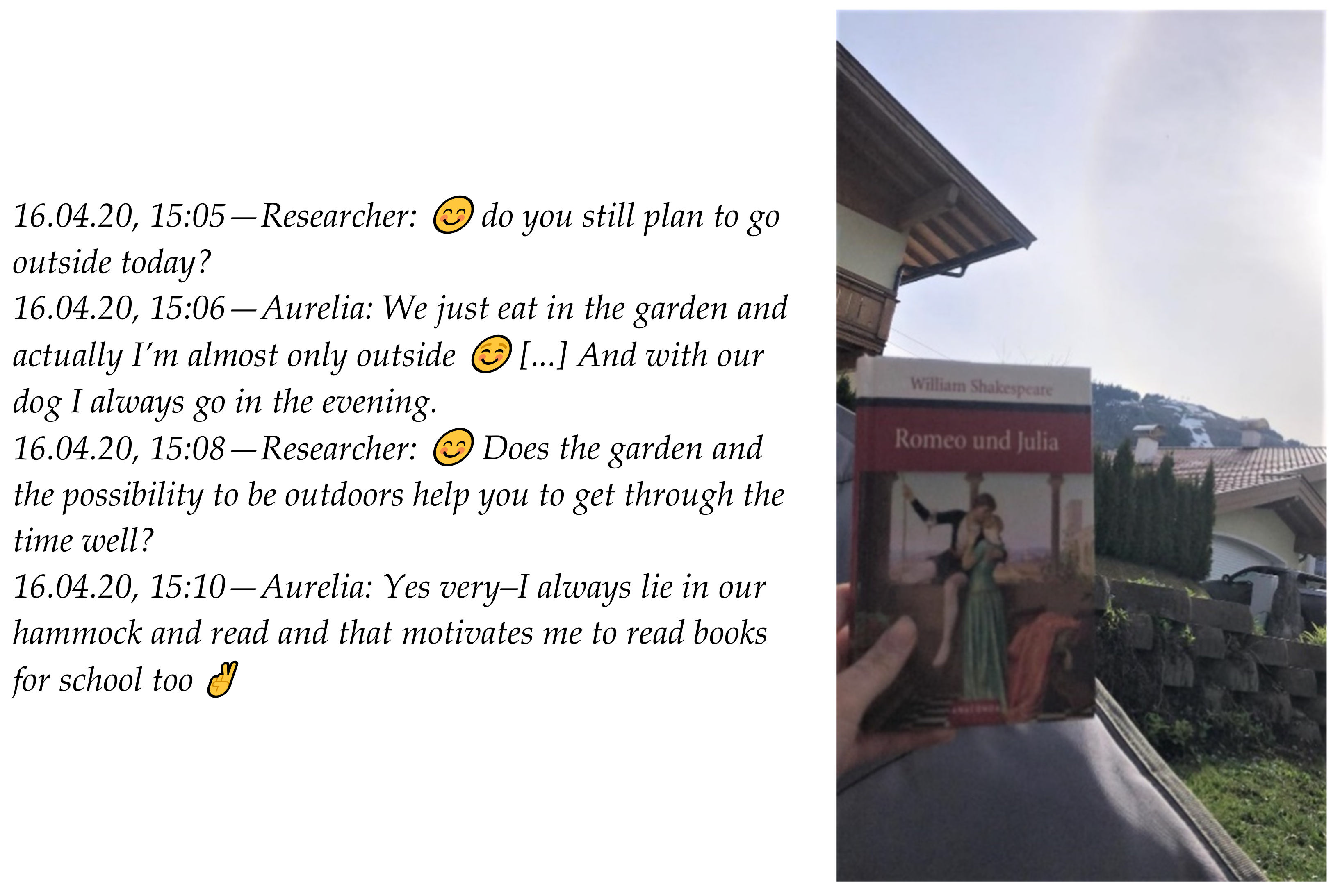Graduating during the COVID-19 Pandemic: Digital Media Practices and Learning Spaces among Pupils Taking Their School-Leaving Exams
Abstract
:1. Introduction
- What did pupils’ socio-material-technological learning spaces look like during this period?
- How did they adapt their digital media practices to cope with learning remotely?
- How did their situatedness in these learning spaces influence their learning experiences and success?
2. Theoretical Approach and Literature Review
2.1. Digital Media Practices and cON/FFlating Learning Spaces
2.2. The COVID-19 Pandemic and Remote Learning
3. Methods: Data Collection during a Pandemic
3.1. Method I: Written Narratives
3.2. Method II: Mobile Instant Messaging Interviews
3.3. Combined and Sequential Data Analysis: Content and Narrative Analyses
4. Results
4.1. Pupils’ Experiences with Remote Learning and Preparing from a Distance for the School-Leaving Exams during the First Lockdown
“For me the change to distance learning was very difficult. […] But when the teachers, who usually hardly go through any material, think that they have to give the pupils something to do, and since every teacher does that, it is very stressful. […] In addition, most teachers take advantage of the situation to quickly go through all the material they didn’t get through before”.(narrative, DC1)
“certain meetings via an online platform [are] nowhere near as effective as meeting in the same room, and it seems to me that absolutely nothing is said in those meetings, and you’re going around in circles rather than really getting anything done”.(narrative, DC1)
“There are actually no big challenges; the daily routine has only shifted from school to home”.(narrative, DC1)
“After all, we have been working a lot with laptops for almost 3 years now, and in these months, we would only be preparing for the upcoming Matura anyway. Rather the opposite—I find the current situation rather takes the pressure off, as I have time to focus on the things I’m still struggling with”.(narrative, DC1)
4.2. Situating Experiences with Remote Learning in Individual cON/FFlating Spaces
4.2.1. Mike: Diving into the Digital and the Role of Polymedia
“Basically, I have to confess that my grades have gotten a little worse through my own fault and downright demotivation from sitting around at home all the time. I even think it’s a bit of a shame that I didn’t have a normal Matura, because I’m a person who needs a bit of pressure to achieve better results. […] Instead of more stress, I got real relief, and even when there was a lot to do at the beginning, due to the work assignments, I fell more and more out of the system, because it felt too much like a vacation”.(narrative, DC1)
4.2.2. Louisa: Striving for a Balanced Digital Media Use Amidst Complicated Family Relations and a Stressful Home Space
“I go out as rarely as possible (only for shopping), and I also abstain from walks that are still allowed. Also, in the apartment, I keep as much distance as possible and stay mainly in my room to do tasks for school or to talk with my friends on the Internet and play together. The only exception [when I see my grandma] is eating together at lunch and sometimes in the evening. This is also a very difficult time for my grandma”.(narrative, DC1)
“All these contacts (school, club, and friends from former schools) are minimized so that there is only contact via telephone or via video conference (especially used for the training sessions in the team to still have the feeling that you train together)”.(narrative, DC1)
“As soon as I am awake, I can be reached online. […] This constant ‘I’m online and available’ is an unconscious pressure that you always have to be ready to give answers—to fulfill obligations in the form of duties, and which is of course much greater now than before, because everyone assumes that now with the curfew, EVERYONE is online anyway and has nothing better to do than chat and keep in touch with their friends”.(narrative, DC1)
“Drawing with different media and trying new ones, photography—I find the time again to keep my kind of diary (which by the way helps a lot to process the situation) and manage to keep my room tidy”.(narrative, DC1)
“I am still online a lot, but ‘offline contacts’ are no longer unattended”.(narrative, DC2)
4.2.3. Aurelia: Withdrawing from the Digital through Escape into Outdoor Spaces
5. Discussion
6. Conclusions
Author Contributions
Funding
Institutional Review Board Statement
Informed Consent Statement
Data Availability Statement
Acknowledgments
Conflicts of Interest
References
- Million, A. ‘No one listens to us…’ COVID-19 and its socio-spatial impact on children and young people in Germany. Child. Geogr. 2021, 1–9. [Google Scholar] [CrossRef]
- UNESCO. Global Monitoring of School Closures Caused by COVID-19. 2020. Available online: https://www.unesco.org/en/covid-19/education-response (accessed on 2 September 2021).
- Viner, R.M.; Russell, S.J.; Croker, H.; Packer, J.; Ward, J.; Stansfield, C.; Mytton, O.; Bonell, C.; Booy, R. School closure and management practices during coronavirus outbreaks including COVID-19: A rapid systematic review. Lancet Child Adolesc. Health 2020, 4, 397–404. [Google Scholar] [CrossRef]
- Roe, A.; Blikstad-Balas, M.; Dalland, C.P. The Impact of COVID-19 and Homeschooling on Students’ Engagement with Physical Activity. Front. Sports Act. Living 2021, 2, 589227. [Google Scholar] [CrossRef] [PubMed]
- Nusser, L.; Wolter, I.; Attig, M.; Fackler, S. Die Schulschließungen aus Sicht der Eltern. Ergebnisse des längsschnittlichen Nationalen Bildungspanels und seiner COVID-19-Zusatzbefragung. In Schule Während Der Corona-Pandemie: Neue Ergebnisse und Überblick über Ein Dynamisches Forschungsfeld; Fickermann, D., Edelstein, B., Eds.; Waxmann Verlag GmbH: Münster, Germany, 2021; pp. 33–50. [Google Scholar]
- Rose-Redwood, R.; Kitchin, R.; Apostolopoulou, E.; Rickards, L.; Blackman, T.; Crampton, J.; Rossi, U.; Buckley, M. Geographies of the COVID-19 pandemic. Dialog. Hum. Geogr. 2020, 10, 97–106. [Google Scholar] [CrossRef]
- Polakovic, G. How Does Coronavirus Affect Young People’s Psyches? Available online: https://news.usc.edu/167275/how-does-coronavirus-affect-young-people-psyches/ (accessed on 27 December 2021).
- Hoffman, L. Distancing, and Adolescence. Available online: https://www.psychologytoday.com/us/blog/beyond-freud/202003/covid-19-pandemic-social-distancing-and-adolescence (accessed on 27 December 2021).
- Bork-Hüffer, T.; Mahlknecht, B.; Markl, A. Kollektivität in und durch cON/FFlating spaces. Zeitschrift für Kultur-und Kollektivwissenschaft 2020, 6, 131–170. [Google Scholar] [CrossRef]
- Card, P.; Thomas, H. Student housing as a learning space. J. Geogr. High. Educ. 2018, 42, 1–15. [Google Scholar] [CrossRef]
- Kitchin, R. Space II. In International Encyclopedia of Human Geography; Elsevier: Oxford, UK, 2009; Volume 10, pp. 268–275. Available online: https://kitchin.org/wp-content/uploads/2019/04/IEHG-Space-2009.pdf (accessed on 1 September 2021).
- Massey, D. For space. Los Angeles: SAGE. 2005. Available online: https://selforganizedseminar.files.wordpress.com/2011/07/massey-for_space.pdf (accessed on 2 December 2021).
- Beyes, T.; Steyaert, C. Spacing organization: Non-representational theory and performing organizational space. Organization 2012, 19, 45–61. [Google Scholar] [CrossRef]
- Brooks, R.; Waters, J. Student Mobilities, Migration and the Internationalization of Higher Education; Springer: Berlin/Heidelberg, Germany, 2011. [Google Scholar]
- Beckers, R.; Van Der Voordt, T.; Dewulf, G.P. A conceptual framework to identify spatial implications of new ways of learning in higher education. Facilities 2015, 33, 2–19. [Google Scholar] [CrossRef]
- Brooks, R.; Waters, J. Materialities and Mobilities in Education; Routledge: London, UK, 2017. [Google Scholar]
- Kraftl, P.; Andrews, W.; Beech, S.; Ceresa, G.; Holloway, S.L.; Johnson, V.; White, C. Geographies of education: A journey. Area 2022, 54, 15–23. [Google Scholar] [CrossRef]
- Boys, J. Towards Creative Learning Spaces; Routledge: London, UK, 2010. [Google Scholar]
- Cross, J. Informal Learning: Rediscovering the Natural Pathways That Inspire Innovation and Performance; John Wiley & Sons: Hoboken, NJ, USA, 2011. [Google Scholar]
- Brooks, R.; Fuller, A.; Waters, J. Changing spaces of education: An introduction. In Changing Spaces of Educatio; Routledge: London, UK, 2012. [Google Scholar]
- Abeele, M.M.P.V. Mobile youth culture: A conceptual development. Mob. Media Commun. 2016, 4, 85–101. [Google Scholar] [CrossRef]
- De Almeida, A.N.; Delicado, A.; Alves, N.; Carvalho, T. Internet, children and space: Revisiting generational attributes and boundaries. New Media Soc. 2015, 17, 1436–1453. [Google Scholar] [CrossRef]
- Thulin, E.; Vilhelmson, B.; Schwanen, T. Absent Friends? Smartphones, Mediated Presence, and the Recoupling of Online Social Contact in Everyday Life. Ann. Am. Assoc. Geogr. 2020, 110, 166–183. [Google Scholar] [CrossRef] [Green Version]
- Bencsik, A.; Machová, R.; Zsigmond, T. Analysing Customer Behaviour in Mobile App Usage Among the Representatives of Generation X and Generation Y. J. Appl. Econ. Sci. 2018, 13, 1669–1678. [Google Scholar]
- Madianou, M.; Miller, D. Polymedia: Towards a new theory of digital media in interpersonal communication. Int. J. Cult. Stud. 2013, 16, 169–187. [Google Scholar] [CrossRef] [Green Version]
- Croitoru, A.; Wayant, N.; Crooks, A.; Radzikowski, J.; Stefanidis, A. Linking cyber and physical spaces through community detection and clustering in social media feeds. Comput. Environ. Urban Syst. 2015, 53, 47–64. [Google Scholar] [CrossRef]
- Silva, A.D.S.E. Location-aware mobile technologies: Historical, social and spatial approaches. Mob. Media Commun. 2013, 1, 116–121. [Google Scholar] [CrossRef]
- Bork-Hüffer, T.; Yeoh, B.S. The geographies of difference in conflating digital and offline spaces of encounter: Migrant professionals’ throwntogetherness in Singapore. Geoforum 2017, 86, 93–102. [Google Scholar] [CrossRef]
- Bork-Hüffer, T.; Mahlknecht, B.; Kaufmann, K. (Cyber)Bullying in schools—When bullying stretches across cON/FFlating spaces. Child. Geogr. 2021, 19, 241–253. [Google Scholar] [CrossRef]
- Barad, K. Meeting the Universe Halfway: Quantum Physics and the Entanglement of Matter and Meaning; Duke University Press: Durham, NC, USA, 2007. [Google Scholar] [CrossRef] [Green Version]
- UNESCO Global Dataset on the Duration of School Closures. Total Duration of School Closures. Available online: https://en.unesco.org/covid19/educationresponse#durationschoolclosures (accessed on 3 July 2022).
- Nenna, R.; Zeric, H.; Petrarca, L.; Mancino, E.; Midulla, F. Weighing policymaking: A narrative review of school closures as COVID-19 pandemic-mitigation strategies. Pediatr. Pulmonol. 2021. [Google Scholar] [CrossRef]
- Greener, S. Exploring remote distance learning: What is it and should we keep it? Interact. Learn. Environ. 2021, 29, 1–2. [Google Scholar] [CrossRef]
- Beaunoyer, E.; Dupéré, S.; Guitton, M.J. COVID-19 and digital inequalities: Reciprocal impacts and mitigation strategies. Comput. Hum. Behav. 2020, 111, 106424. [Google Scholar] [CrossRef] [PubMed]
- Helm, C.; Huber, S.; Loisinger, T. Was wissen wir über schulische Lehr-Lern-Prozesse im Distanzunterricht während der Corona-Pandemie?—Evidenz aus Deutschland, Österreich und der Schweiz. Z. Für Erzieh. 2021, 24, 237–311. [Google Scholar] [CrossRef] [PubMed]
- Jaekel, A.-K.; Scheiter, K.; Göllner, R. Distance Teaching during the COVID-19 Crisis: Social Connectedness Matters Most for Teaching Quality and Students’ Learning. AERA Open 2021, 7, 233285842110520. [Google Scholar] [CrossRef]
- Cavus, N.; Sani, A.S.; Haruna, Y.; Lawan, A.A. Efficacy of Social Networking Sites for Sustainable Education in the Era of COVID-19: A Systematic Review. Sustainability 2021, 13, 808. [Google Scholar] [CrossRef]
- Sabol, F.R. Art education during the COVID-19 pandemic: The journey across a changing landscape. Arts Educ. Policy Rev. 2021, 123, 127–134. [Google Scholar] [CrossRef]
- Schildkamp, K.; van der Kleij, F.M.; Heitink, M.C.; Kippers, W.B.; Veldkamp, B.P. Formative assessment: A systematic review of critical teacher prerequisites for classroom practice. Int. J. Educ. Res. 2020, 103, 101602. [Google Scholar] [CrossRef]
- Steiner, M.; Köpping, M.; Leitner, A.; Pessl, G.; Lasnigg, L. Lehren und Lernen unter Pandemiebedingungen: Was Tun, Damit Aus Der Gesundheits- Nicht Auch Eine Bildungskrise Wird? Available online: https://irihs.ihs.ac.at/id/eprint/5873/24/ihs-report-2021-steiner-koepping-leitner-pessl-lassnigg-lehren-und-lernen-unter-pandemiebedingungen.pdf (accessed on 3 May 2022).
- Hawrilenko, M.; Kroshus, E.; Tandon, P.; Christakis, D. The Association between School Closures and Child Mental Health During COVID-19. JAMA Netw. Open 2021, 4, e2124092. [Google Scholar] [CrossRef]
- Vogel, M.; Meigen, C.; Sobek, C.; Ober, P.; Igel, U.; Körner, A.; Kiess, W.; Poulain, T. Well-being and COVID-19-related worries of German children and adolescents: A longitudinal study from pre-COVID to the end of lockdown in Spring 2020. JCPP Adv. 2021, 1, e12004. [Google Scholar] [CrossRef]
- Greenhow, C.; Chapman, A. Social distancing meet social media: Digital tools for connecting students, teachers, and citizens in an emergency. Inf. Learn. Sci. 2020, 121, 341–352. [Google Scholar] [CrossRef]
- Gupta, T.; Swami, M.K.; Nebhinani, N. Risk of digital addiction among children and adolescents during COVID-19 pandemic: Concerns, caution, and way out. J. Indian Assoc. Child Adolesc. Ment. Health 2020, 16, 199–208. [Google Scholar]
- Peil, C. Polymedia in der Krise. (Außer-)Alltägliches Medienhandeln während des ersten Lockdowns in Österreich. MedienJournal 2021, 45, 53–72. [Google Scholar] [CrossRef]
- World Health Organization. Joint Leaders’ Statement: Violence against Children: A Hidden Crisis of the COVID-19 Pandemic. Available online: https://www.who.int/news/item/08-04-2020-joint-leader-s-statement---violence-against-children-a-hidden-crisis-of-the-covid-19-pandemic (accessed on 27 December 2021).
- Reuschke, D.; Felstead, A. Changing workplace geographies in the COVID-19 crisis. Dialog. Hum. Geogr. 2020, 10, 208–212. [Google Scholar] [CrossRef]
- Ravens-Sieberer, U.; Kaman, A.; Erhart, M.; Devine, J.; Schlack, R.; Otto, C. Impact of the COVID-19 pandemic on quality of life and mental health in children and adolescents in Germany. Eur. Child Adolesc. Psychiatry 2021, 31, 879–889. [Google Scholar] [CrossRef]
- Kaufmann, K. Mobile Methods: Doing Migration Research with the Help of Smartphones. In The SAGE Handbook of Media and Migration; Smets, K., Leurs, K., Georgiou, M., Witteborn, S., Gajjala, R., Eds.; SAGE Publications: Thousand Oaks, CA, USA, 2020; pp. 167–180. [Google Scholar]
- Kaufmann, K.; Peil, C. The mobile instant messaging interview (MIMI): Using WhatsApp to enhance self-reporting and explore media usage in situ. Mob. Media Commun. 2019, 8, 229–246. [Google Scholar] [CrossRef]
- Laughland-Booÿ, J.; Skrbis, Z.; Newcombe, P. Identity and Intimacy: A Longitudinal Qualitative Study of Young Australians. J. Adolesc. Res. 2017, 33, 725–751. [Google Scholar] [CrossRef]
- Atkinson, R. The Life Story Interview; Californien: Thousand Oaks, CA, USA, 1998. [Google Scholar]
- Pabian, S.; Erreygers, S. Generating Personal Stories on Negative Online Peer Interactions through a Photo-Elicitation Method. In Narratives in Research and Interventions on Cyberbullying among Young People; Vandebosch, H., Green, L., Eds.; Springer International Publishing: Cham, Switzerland, 2019; pp. 77–93. [Google Scholar]
- Schulze, T. Zur Interpretation autobiographischer Texte in der erziehungswissenschaftlichen Biographieforschung. In Handbuch Qualitative Forschungsmethoden in der Erziehungswissenschaft; Werner, H., Friebertshäuser, B., Prengel, A., Eds.; Beltz Juventa: München, Germany, 2010; pp. 413–436. [Google Scholar]
- Kaufmann, K.; Peil, C.; Bork-Hüffer, T. Producing In Situ Data from a Distance with Mobile Instant Messaging Interviews (MIMIs): Examples from the COVID-19 Pandemic. Int. J. Qual. Methods 2021, 20, 160940692110296. [Google Scholar] [CrossRef]
- Pabian, S.; Erreygers, S. Narratives in Research and Interventions on Cyberbullying among Young People; Vandebosch, H., Green, L., Eds.; Springer International Publishing: Cham, Switzerland, 2019. [Google Scholar]
- Mayring, P. Qualitative Inhaltsanalyse. Available online: https://www.qualitative-research.net/index.php/fqs/article/view/1089/2383 (accessed on 27 December 2021).
- Mayring, P. Qualitative Content Analysis: Theoretical Foundation, Basic Procedures and Software Solution. Available online: https://www.ssoar.info/ssoar/bitstream/handle/document/39517/ssoar-2014-mayring-Qualitative_content_analysis_theoretical_foundation.pdf (accessed on 27 December 2021).
- Kuper, L.E.; Mustanski, B.S. Using Narrative Analysis to Identify Patterns of Internet Influence on the Identity Development of Same-Sex Attracted Youth. J. Adolesc. Res. 2014, 29, 499–532. [Google Scholar] [CrossRef]
- Wiles, J.L.; Rosenberg, M.W.; Kearns, R.A. Narrative analysis as a strategy for understanding interview talk in geographic research. Area 2005, 37, 89–99. [Google Scholar] [CrossRef]
- House-Peters, L.A.; Del Casino, V.; Brooks, C.F. Dialogue, inquiry, and encounter: Critical geographies of online higher education. Prog. Hum. Geogr. 2017, 43, 81–103. [Google Scholar] [CrossRef]
- Darmody, M.; Smyth, E.; Russell, H. Impacts of the COVID-19 Control Measures on Widening Educational Inequalities. YOUNG 2021, 29, 366–380. [Google Scholar] [CrossRef]
- Dimopoulos, K.; Koutsampelas, C.; Tsatsaroni, A. Home schooling through online teaching in the era of COVID-19: Exploring the role of home-related factors that deepen educational inequalities across European societies. Eur. Educ. Res. J. 2021, 20, 479–497. [Google Scholar] [CrossRef]
- Wößmann, L. Bildungsverluste durch Corona: Wie lassen sie sich aufholen? Wirtschaftsdienst 2021, 101, 150–151. [Google Scholar] [CrossRef] [PubMed]
- Torda, A. How COVID-19 has pushed us into a medical education revolution. Intern. Med. J. 2020, 50, 1150–1153. [Google Scholar] [CrossRef] [PubMed]
- Dos Santos, V.A.; Dantas, V.R.; Gonçalves, A.; Holanda, B.; de Andrade Gaião e Barbosa, A. O Uso Das Ferramentas Digitais No Ensino Remoto Acadêmico: Desafios E Oportunidades NA Perspectiva Docente. 2020. Available online: https://editorarealize.com.br/editora/anais/conedu/2020/TRABALHO_EV140_MD1_SA19_ID3875_31082020225021.pdf (accessed on 3 June 2022).
- Dias, A.; Scavarda, A.; Silveira, H.; Scavarda, L.F.; Kondamareddy, K.K. The Online Education System: COVID-19 Demands, Trends, Implications, Challenges, Lessons, Insights, Opportunities, Outlooks, and Directions in the Work from Home. Sustainability 2021, 13, 12197. [Google Scholar] [CrossRef]
- Gryl, I.; Jekel, T. Spatially Informed Citizenship Education as an Approach for Global Understanding. In Geography Education for Global Understanding; Demirci, A., de Miguel González, R., Bednarz, S.W., Eds.; Springer International Publishing: Cham, Switzerland, 2018; pp. 43–56. [Google Scholar]
- Dorsch, C.; Kanwischer, D. Mündigkeit in einer Kultur der Digitalität—Geographische Bildung und “Spatial Citizenship”. Z. Für Didakt. Der Ges. 2020, 11, 23–40. [Google Scholar] [CrossRef]




Publisher’s Note: MDPI stays neutral with regard to jurisdictional claims in published maps and institutional affiliations. |
© 2022 by the authors. Licensee MDPI, Basel, Switzerland. This article is an open access article distributed under the terms and conditions of the Creative Commons Attribution (CC BY) license (https://creativecommons.org/licenses/by/4.0/).
Share and Cite
Mahlknecht, B.; Kempert, R.; Bork-Hüffer, T. Graduating during the COVID-19 Pandemic: Digital Media Practices and Learning Spaces among Pupils Taking Their School-Leaving Exams. Sustainability 2022, 14, 8628. https://doi.org/10.3390/su14148628
Mahlknecht B, Kempert R, Bork-Hüffer T. Graduating during the COVID-19 Pandemic: Digital Media Practices and Learning Spaces among Pupils Taking Their School-Leaving Exams. Sustainability. 2022; 14(14):8628. https://doi.org/10.3390/su14148628
Chicago/Turabian StyleMahlknecht, Belinda, Richard Kempert, and Tabea Bork-Hüffer. 2022. "Graduating during the COVID-19 Pandemic: Digital Media Practices and Learning Spaces among Pupils Taking Their School-Leaving Exams" Sustainability 14, no. 14: 8628. https://doi.org/10.3390/su14148628
APA StyleMahlknecht, B., Kempert, R., & Bork-Hüffer, T. (2022). Graduating during the COVID-19 Pandemic: Digital Media Practices and Learning Spaces among Pupils Taking Their School-Leaving Exams. Sustainability, 14(14), 8628. https://doi.org/10.3390/su14148628





